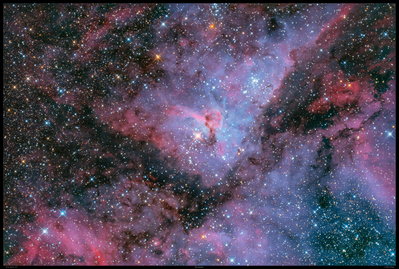Carina Nebula in HDR and full colour

- Carina Nebula ( NGC 3372 ) and stars in HDR and full colour
This HDR image is constructed from 12 sets of exposures ranging from 1/8 sec ( to capture the bright centre of Eta Carinae ) through to 240 seconds. Total exposure time around 13 hours. Captured from a home observatory with an unmodified Nikon D5300 DSLR mounted on a 12" Newtonian telescope ( Orion Optics CT12 ).
17-19 March 2018
My image gallery:
http://flickr.com/photos/mike-oday
Image details:
Objects in image:
Eta Carinae ( HD 93308 ) in the centre of the Homunculus Nebula
Carina Nebula ( NGC 3372 )
Keyhole Nebula
Open Star Clusters:
- Trumpler 14, 15, 16
- Collinder 232
Field of view ..... 59' 18.2" x 39' 56.0"
Image center ...... RA: 10 45 01.762 Dec: -59 40 52.87
Orientation: North is up
Telescope: Orion Optics CT12 Newtonian ( mirror 300mm, fl 1200mm, f4 ).
Corrector: ASA 2" Coma Corrector Quattro 1.175x.
Effective Focal Length / Aperture : 1470mm f4.7
Mount: Skywatcher EQ8
Guiding: TSOAG9 Off-Axis-Guider, Starlight Xpress Lodestar X2, PHD2
Camera:
Nikon D5300 (unmodified) (sensor 23.5 x 15.6mm, 6016x4016 3.9um pixels)
Location:
Blue Mountains, Australia
Moderate light pollution ( pale green zone on darksitefinder.com map )
Capture ( 17, 18 19 March 2018 ):
12 sets of sub-images with exposure duration for each set doubling ( 1/8s to 240s ) all at ISO250.
( 181 x 240sec + 10 to 20 each for the other durations )
Processing:
Calibration: master bias, master flat and master dark
Integration in 12 sets
HDR combination